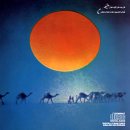The Ups and Downs of Carlos Santana
Part One: Caravanserai
First Appeared at The Music Box, January 2004, Volume 11, #1
Written by John Metzger
![]()
Everyone seemed shocked and surprised when Carlos Santana unleashed the blockbuster Supernatural on the world. Without a doubt, it was overtly more pop-oriented than anything he had previously put together, yet it also wasnít completely out-of-step with his career-long struggle for commercial viability. Itís been 34 years since Santana released his first album. In that time, heís dabbled in everything from Latin rock to jazz-fusion, from soul to blues, from psychedelia to R&B. Plenty of pop polish has pulsated through his songs as well. Like an alchemist, heís always experimenting, always mixing sounds and styles to suit his particular need. Sometimes itís worked, other times it hasnít, but such is the nature of his unique vision. In the early 1970s, Santana was focused primarily on interpreting the burgeoning jazz-fusion scene, and three of his albums from this period (Caravanserai, Love Devotion Surrender, and Welcome) as well as a concert recording from 1977 (Moonflower) have recently been remastered and reissued. Here is a look at each:

Santana
Caravanserai
(Columbia/Legacy)
Abraxus, and to a lesser extent, Santana, and Santana III receive nearly all of the attention, but Carlos Santanaís oft-forgotten fourth studio recording Caravanserai is an equally strong outing that finds the guitarist stepping out in a new direction. Steeped in jazz- fusion, the album rolls along at a comfortable pace, so much so that this, perhaps, explains why itís been so difficult for many to fully grasp.
Itís not that Caravanserai is really that different from Santanaís
previous efforts. All he really does is expand upon the instrumental segments of
his first three albums, but this time, he parlays them into a cohesive suite of
songs that is, at times, as breathtakingly beautiful as Miles Davisí In a Silent Way and, at other times, as frenetic as Davisí Bitches Brew.
Right from the start, he charts out Caravanseraiís sonic space, beginning
with the serene sound of crickets to which is added the guttural groan of
saxophone and a percussive groove straight from John Coltraneís Africa/Brass.
Indeed, that is the foundation upon which Santana builds this monumental effort,
which bursts at the seams with thoughts and ideas while careening effortlessly
through a blend of Latin rock, blues, and soul. He masterfully reinvents Antonio
Carlos Jobimís Stone Flower, dives into the heady funk-rock swirl of
Look Up (To See Whatís Coming Down), and delivers Song of the Wind
with supreme tenderness. Through it all, the magisterial tone of Santanaís
guitar freely darts and glides above the clattering rhythms sculpted by a sextet
of percussionists. Indisputably original when it was released in 1972,
Caravanserai has held up remarkably well over the years and continues to
rank among the most vital outings of Santanaís career. There are no bonus tracks
on the updated release, but then again, thereís no reason to mess with
perfection. ![]()
![]()
![]()
![]()
![]()
![]()
![]()
![]()
Of Further Interest...
Santana - Love Devotion Surrender
![]()
Caravanserai is available from Barnes & Noble.
To order, Click Here!
![]()
Ratings
1 Star: Pitiful
2 Stars: Listenable
3 Stars: Respectable
4 Stars: Excellent
5 Stars: Can't Live Without It!!
![]()
Copyright © 2003 The Music Box
